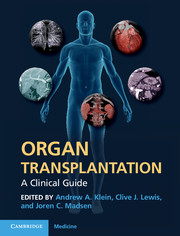Book contents
- Organ Transplantation
- Organ Transplantation
- Copyright page
- Contents
- Contributors
- Foreword
- Preface
- Abbreviations
- Section 1 General
- Chapter 1 Historical perspectives
- Chapter 2 Immunological principles of acute rejection
- Chapter 3 Immunosuppression
- Chapter 4A Major complications – cancer
- Chapter 4B Major complications – pathology of chronic rejection
- Chapter 4C Major complications – infection
- Chapter 5 Organ donor management and procurement
- Section 2 Heart
- Section 3 Lung
- Section 4 Liver
- Section 5 Kidney
- Section 6 Other abdominal organs
- Section 7 Other
- Section 8 The transplant service
- Index
Chapter 4C - Major complications – infection
from Section 1 - General
Published online by Cambridge University Press: 07 September 2011
- Organ Transplantation
- Organ Transplantation
- Copyright page
- Contents
- Contributors
- Foreword
- Preface
- Abbreviations
- Section 1 General
- Chapter 1 Historical perspectives
- Chapter 2 Immunological principles of acute rejection
- Chapter 3 Immunosuppression
- Chapter 4A Major complications – cancer
- Chapter 4B Major complications – pathology of chronic rejection
- Chapter 4C Major complications – infection
- Chapter 5 Organ donor management and procurement
- Section 2 Heart
- Section 3 Lung
- Section 4 Liver
- Section 5 Kidney
- Section 6 Other abdominal organs
- Section 7 Other
- Section 8 The transplant service
- Index
Summary
- Type
- Chapter
- Information
- Organ TransplantationA Clinical Guide, pp. 46 - 52Publisher: Cambridge University PressPrint publication year: 2011
- 1
- Cited by



